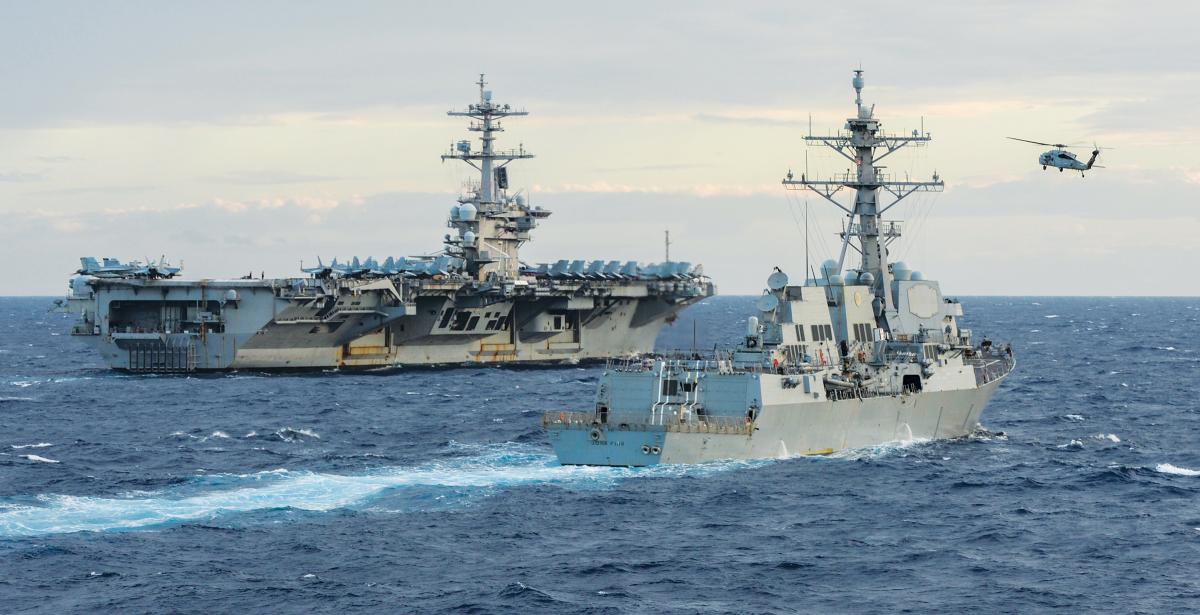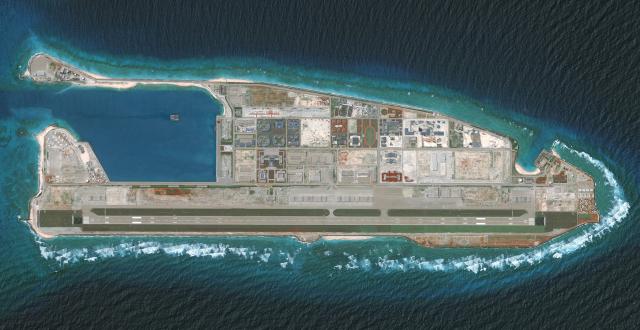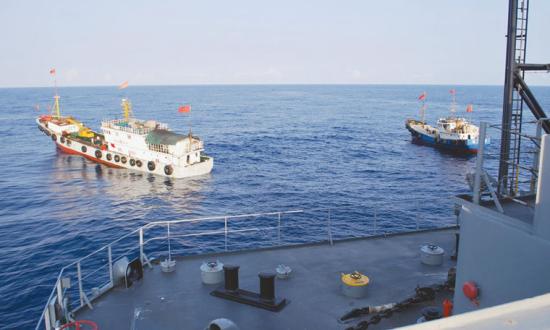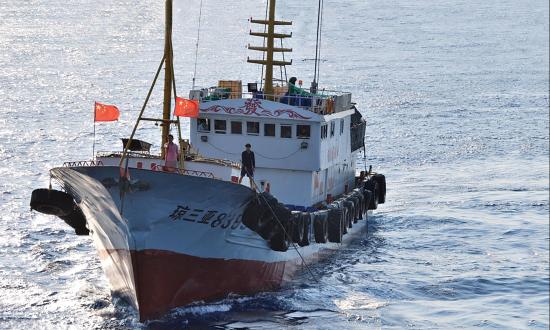In an increasingly globalized world, international treaties and conventions have only gained importance in economic, diplomatic, and military matters. While the Geneva Convention after World War II and the more recent Paris Agreement on climate change are intended to benefit every country, there are instances in which states do not commit themselves to such joint efforts. One such case is that of the United Nations Convention on the Law of the Sea (UNCLOS), which was formulated and opened for signing in December 1982.
UNCLOS was ratified by 60 states and entered into effect in 1994 as a single, encompassing framework developed to define sea borders of coastal states, support maritime economies, guarantee navigational rights and freedoms, protect the ocean as an environment, and preserve peace on the high seas.1 Since then, 108 more states have joined the convention; the United States has not.2 Despite having adopted the common practices outlined in the treaty and accepting UNCLOS as customary international law, the United States has yet to accede to the convention—a fact that is immensely relevant to the U.S. Navy and particularly the surface warfare community.
Why UNCLOS?
Before the development of UNCLOS, the maritime concept that stood above all was simply “freedom of the seas,” which belonged to no one state.3 In 1945, President Harry S. Truman became the first leader to challenge this by claiming rights to the United States’ continental shelf and all resources within.4 Following this example, many states began claiming territorial seas up to 12 nautical miles from their coast.5 Years passed, and the world’s oceans were exploited limitlessly through activities such as lawless fishing and oil exploration.6 Thus, the need for a set of international standards was born from growing anxiety among world leaders that unbridled exploitation would eventually lead to legal, environmental, and military disputes.
UNCLOS was adopted in 1982 to codify widely accepted international customary law regarding navigational freedom and rights of vessels on the high seas while defining a state’s jurisdiction over resources in their exclusive economic zones (EEZs) and coastal continental shelves.7 The convention includes provisions regarding the coastal state jurisdiction in maritime zones, protections against damage to the maritime environment, and passage through territorial seas, international straits, and archipelagic waters.8 The United States exhibited great influence in the early years of the convention’s development, yet at present it has little influence because of its non-signatory status. The argument continues today as revisionists, such as China and Russia, challenge American influence abroad: Should the United States finally join the treaty?
Why Not UNCLOS?
President Ronald Reagan and several public and private sector leaders had misgivings about the final treaty. The most explicit of these regards Part XI, which concerns states’ rights to deep seabed mining.9 Industrialized nations at the time, including the United States, believed that private operations and market opportunities would be squandered by UNCLOS’ establishment of the International Seabed Authority (ISA) to grant permission to states to conduct deep seabed mining.10 Other provisions that concerned these states included limits on deep sea exploration as well as an initially mandated transfer of related technology to the international community.11
These concerns were irrelevant with respect to the rest of the convention and were renegotiated in the 1990s. And yet, even in the convention's initial draft, there was not much to fret about. Deep seabed mining was not viable at the time, but rather a potential source of copious natural material and thus market success; in fact, it was argued at the time that the deep seabed would be the “least used area addressed by the Convention.”12 Beyond this, the provisions regarding technology transfer and a production ceiling were unlikely to affect projects in deep seabed mining and ocean exploration.13 This begs the question: What really stopped the United States from ratifying UNCLOS in the 1980s?
Experts then and now, disregarding initial concerns, largely agree that the decision of the United States not to sign UNCLOS in 1982 was more ideological than practical. At the time, the Reagan administration aimed to close out the Cold War and age of communism that had become anathema in American society. Thus, it was argued that President Reagan made his choice not only for perceived economic ramifications, but with the intent of standing against the convention’s overarching theme of globalization, which harbored implications of shared wealth and resources for developing and land-locked states.14
Many U.S. leaders opposed the decision not to ratify UNCLOS, including scholars who understood the political consequences of the United States walking away from a treaty in whose creation it had taken part. By removing itself from the convention, the United States also distanced itself from beneficial environmental practices and navigational freedoms. The political popularity of UNCLOS has waxed and waned through the past seven U.S. presidential administrations and is still a pertinent discussion today, in an atmosphere where the United States is not necessarily still a hegemon.
The United States and UNCLOS Today
In 2021, nearly 40 years since the inception of UNCLOS, the two sides of the debate generally boil down to: (a) “This treaty is worth nothing to the United States now that the state has existed outside of it for so long”; or (b) “This treaty is more important today than it was initially because of international developments.”
Combatting China and Russia
The U.S. National Defense Strategy of 2018 focuses heavily on the need for the United States to combat the influence of revisionist powers China and Russia, who have gained a greater hold on the global stage in the past 20 years. As a non-signatory of UNCLOS, the United States has hindered its influence over these two adversaries regarding the law of the sea, despite explicitly recognizing the significance of each state’s growing power in strategic documents.
The Arctic has experienced unprecedented high temperatures in recent years and continues to melt, opening summer navigation routes and making resources available that have not been easily accessible in the past.15 This, of course, has opened international discourse concerning which states have rights to what resources in the Arctic. In the U.S. Senate’s Committee on Foreign Relations hearings in 2012, both then–Secretary of State Hillary Clinton and Secretary of Defense Leo Panetta stressed the opportunities that are waiting in the Arctic.16 While the United States is a member of the Arctic Council, it is the only member that is not a signatory of UNCLOS, putting it at a disadvantage as the convention will have the ultimate say on how resource and maritime claims are decided.17 Russia has already attempted to claim much of the Arctic, sending its own submarines to the North Pole and planting a flag on the ocean bottom as a symbol of its claim, which is widely disputed.18 When the United States refutes such claims on the basis of international law, Russia and China point out that it has no legal standing because it has not ratified UNCLOS. The cost of doing so is nonexistent, and the reward is the ability to check Russia more effectively.
In the South China Sea, a graver situation has developed involving territorial conflict between China and at least five other nations. China began making artificial islands in 2013, developing 3,200 acres of artificial landmass that it used to claim additional airspace, territorial waters, and a larger exclusive economic zone (EEZ) that overlaps those of other states who are party to UNCLOS. The United States has challenged China’s claims, again with the aim of containing Beijing’s influence over South East Asia. Like Russia, however, China sees no reason to respect the U.S. position because it is not a signatory of UNCLOS.19 Some may argue that a continuous display of U.S. naval strength in China’s backyard (through freedom of navigation operations) is enough to counter Chinese hegemony. But diplomatic power is just as important, especially because other smaller and less powerful nations in the region need help that the United States is challenged to give as an outsider to UNCLOS. In fact, one may argue that during the past 20 years, Washington has relied so heavily on military strength that U.S. soft power has diminished. Being on the outside of the international community has further emboldened revisionist powers such as China and Russia.
U.S. Military Position
Since the convention was adopted in 1982, every Chairman of the Joint Chiefs of Staff has supported its ratification.20 Although there were initial concerns regarding a threat to national security, they were never grounded in evidence, and it has been argued by many that the treaty would increase the capabilities of the U.S. Navy. The Navy Judge Advocate General supports UNCLOS, stating:
The Convention is in the national interest of the United States because it establishes stable maritime zones, including a maximum outer limit for territorial seas; codifies innocent passage, transit passage, and archipelagic sea lanes passage rights; works against “jurisdictional creep” by preventing coastal nations from expanding their own maritime zones; and reaffirms sovereign immunity of warships, auxiliaries and government aircraft.21
This sentiment was echoed by then–Chairman of the Joint Chiefs of Staff General Martin Dempsey, U.S. Army, in his 2012 statement before the Senate Committee on Foreign Relations: “Joining the Convention would strengthen our ability to apply sea power. . . . It reinforces the sovereign immunity of our warships as they conduct operations. . . . We currently rely on customary international law and assert it through our physical presence.” Dempsey added that the U.S. failure to ratify UNCLOS enables the disagreeable behavior of adversaries and thus allows a greater possibility for escalation of regular military operations into more dire situations.22
The Heritage Foundation, which was one of the most vocal groups in fighting the initial accession to UNCLOS, argues that because the United States has remained a non-signatory for so long, there is no reason to change now, and the state’s focus should primarily be on maintaining a superior navy to support its own maritime bidding.23 However, this view ignores the power of diplomacy; as a nonmember of the treaty, the United States has less influence over the ongoing ocean policy discussions of today. Joining the convention would increase U.S. influence over the conversation now, and thus help to solidify U.S. maritime policy and strengthen influence abroad.
Nearly 40 years ago, the Reagan administration and the U.S. Senate backed away from UNCLOS for reasons that made little sense then and none today. Since then, a number of presidents, including Bill Clinton, George H. W. Bush, and Barack Obama, have unsuccessfully lobbied for the Senate to ratify it. For the United States to retake its position as a global leader, and for the U.S. Navy to be seen as a legitimate extension of that leadership, it is time for the Senate to finally give its advice and consent to accede to UNCLOS. The Navy’s surface combatants effectively project American power abroad and enforce freedom of the seas in routine freedom of navigation operations. This mission has become especially significant in the wake of aggressive actions and provoking claims at sea made by our adversaries abroad. However, exerting military strength is not enough. The formal acceptance of UNCLOS by the United States will diplomatically support national interests abroad, secure American influence in the maritime domain, and more proactively underpin the efforts of the U.S. surface navy.
1. “The United Nations Convention on the Law of the Sea (A Historical Perspective)."
2. “Chronological Lists of Ratifications of."
3–6. “The United Nations Convention on the Law of the Sea (A Historical Perspective).”
7. Andrew J. Norris, “The ‘Other’ Law of the Sea,” Naval War College Review 64, no. 3 (2011): 78–81.
8. Norris, “The ‘Other’ Law of the Sea,” 83–84.
9. “UNCLOS_e.Pdf."
10. John R. Stevenson and Bernard Oxman, “The Future of the United Nations Convention on the Law of the Sea,” (University of Miami Law School, 1994), 488–89.
11. Steven J. Molitor, “The Provisional Understanding Regarding Deep Seabed Matters: An Ill-Conceived Regime for U.S. Deep Seabed Mining,” Cornell International Law Journal 20, no. 1 (1987): 31, 242.
12. Stevenson and Oxman, 490.
13. Molitor, “The Provisional Understanding Regarding Deep Seabed Matters,” 242.
14. Molitor, 242.
15. Randy W. Tong, “It’s Time to Get off the Bench: The U.S. Needs to Ratify the Law of the Sea Treaty Before It’s Too Late,” (University of the Pacific, McGeorge School of Law, 2015), 336, faculty.mcgeorge.edu/documents/Publications/tong_TUOPLR482.pdf.
16. The Law of the Sea Convention.
17. Tong, “It's Time to Get Off the Bench,” 336; Elizabeth M. Hudzik, “A Treaty on Thin Ice: Debunking the Arguments Against U.S. Ratification of the U.N. Convention on the Law of the Sea in a Time of Global Climate Crisis,” Washington University Global Studies Law Review, 9, no. 2 (2010): 19, 361.
18. Hudzik, “A Treaty on Thin Ice.”
19. Ben Dolven, Susan V. Lawrence, and Ronald O’Rourke, “South China Sea Disputes: Background and U.S. Policy,” (Congressional Research Service, 2017), 1.
20. The Law of the Sea Convention, 22.
21. “The Convention on the Law of the Sea,” U.S. Navy Judge Advocate General’s Corps.
22. Hearings before the Committee on Foreign Relations, U.S. Senate, 23 May 2012.
23. Ted R. Bromund, James Jay Carafano, Brett D. Shaefer, “7 Reasons U.S. Should Not Ratify UN Convention on the Law of the Sea,” Heritage Foundation, 4 June 2018.







